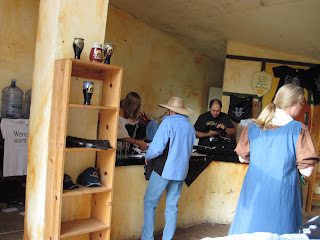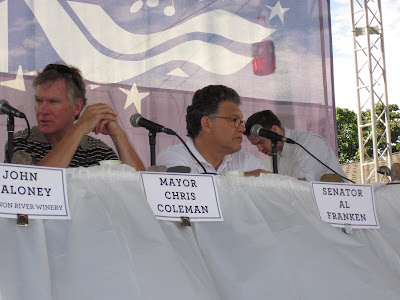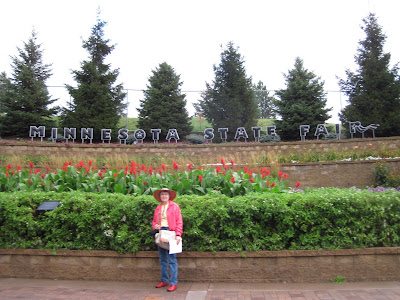Sure, I agree the State Fair is all about food, but not the way you might think. More on that later.
For me, any fair (state or county) is about people and their achievements with animals, crafts, and arts of all kinds. Please let me show you.
On our visit to the Minnesota State Fair on Tuesday, Nancy and I follow the same plan we have for years:
We arrive at the fair before seven to check out the animals before the barns get crowded and before the heat starts to work on the odors. First, we stop to snap a photo of Nancy near the Grandstand.
We arrive at the cow barns before all of the cattle need to get up,
but many hard-working kids and adults are beginning to tend their animals by washing or currying them or by cleaning their stalls.
If you ever catch yourself being cynical about a generation a few notches before yours, a trip to the fair will quickly set you straight. Kids of all sizes work alone or with adults to accomplish every task necessary.
In the swine building, we enjoy watching the kids and adults parade their hogs in front of the judges. Aren't these kids great!
This young woman wins first place with her entry.
We continue on to see poultry, sheep, horses, and fish at the DNR pool, before we take a break in the shade north of the Poultry Building and listen to music by a group from Ecuador as we eat our lunch. We laugh as we witness each fair goer who passes by fall into a little dance. Some do it immediately and others resist till almost out of range, but nearly everyone feels the need to move a bit to the irresistible beat. The shade, the music, and the people-watching keep us there for half an hour.
This little girl dances almost the entire time we are there, taking a break only once in a while to be hugged by her mom.
Now the buildings are getting crowded. We walk through the Miracle of Birth Center, which is packed with kids and adults viewing baby animals of all types,
East of the Miracle of Birth Center is the FFA Chapter House and Leadership Center, and we stop to visit. I've always been a big fan of Future Farmers of America because I know their programs do so much to develop youth confidence.
Jeff Knobloch introduces himself to me. Jeff is from Morris, MN, and is Region III President. As he tells me of his plans to attend the U of M this fall, he grins with enthusiasm.
Since he asks what brings me to the fair, I confess that I am looking for an outlet for my books. He is a real gentleman so he pages through several of them, but I am pleased that he does seem honestly interested. I give him some literature on my books and let him get back to greeting others after wishing him the best of luck at school.

While Jeff and I chat, Nancy meets Erin Daninger and snaps her picture as she talks to the Kruize family from Fargo, ND. Erin is from Forest Lake and is State Secretary of the FFA.
After talking to these two young achievers, Nancy and I agree that the young people in next generation are pretty good hands to be in.
But my pitch for today's youth doesn't stop here. Next we visit the 4-H Building where kids achieve in areas way too numerous and diverse to mention. Students display projects in science, technology, arts and crafts of all kinds, and you will never find a place where you will be greeted by so many genuine smiles from young people and adults.
I like the 4-H pledge, truly a pledge that can help make a better world.
The two girls at the door greet us with big smiles and say "Hello" as we approach.
Here are a few photos of some of the projects:
Making furniture
Making quilts (Nancy is partial to this category)
Painting
Science and technology
Restoration
Activities.
We sit down and rest while we watch little kids learning to jump rope.
We stop to enjoy a performance of "This is Our Time,"a show performed by 4-H actors, singers, dancers and musicians. Costumes, set and technical work are all provided by members of 4-H.
Not only did they do a great job of it all, but can you see those smiles?!
We had met some people from the Farm Bureau at Farmfest , which was August 3-5, so we decide to stop at the Farm Bureau building to talk with members.
Sarah Durenberger and Mike Rouillard welcome us with a fun handout that instructs us where to stop at each of 4 stations and discover answers to questions about farming. On the back of the quiz is a recipe for pizza, and we are referred to displays in front of the building where plants that produce pizza ingredients are growing.
After we finish, Mike and Sarah are kind enough to take time to look at my books. While Mike gives me information explaining whom to contact, Sarah reads through a couple books.
Apparently Sarah is not only smart, but she has great taste. She buys two books and has me sign them before we leave.
We have just enough time to go to the car to get more books before the the Minnesota Cooks Event which begins at 1:00 PM.
Now, I don't mind sounding like the former teacher that I am, so I'll ask, "Do you remember at the start of this blog I said that the Minnesota Stare Fair is all about food but not the way you might think?"
Well, every place I highlighted on this blog teaches about food:
The kids and adults working in the barns can explain what it takes to care for animals, or just watch them and you will see the love they have for what they do.
The animals in the barns are themselves the very food we eat. We need to respect them and the people who care for them.
4-H members are constantly involved with projects that deal with food.
The FFA leaders help lead our future in food production.
The Farm Bureau has programs that show kids and adults facts about food.
No pictures are attached of the Ag Building, but it is full of wall to wall displays of fruits and vegetables and honey and wine. The booths are handled by knowledgeable people in every area.
Notice I didn't mention anything about all the "fair food"everyone raves about, but I figure that corn dogs and foot-longs get enough free publicity from the media.
The things I mention require no money other than your entry and parking fees, but experiencing them does require time and a healthy curiosity.
There are hundreds of great places to visit and learn about food at the fair that I have not mentioned. I urge you to find them all and visit them, and if you have the money, you can always enjoy a foot-long or a corn dog as you visit.
At 1:00 PM we plan to watch Minnesota Cooks Event, sponsored by Food Alliance, Minnesota Farmers Union, Star Tribune and other organizations, and featuring local organic farmers and cooks from local restaurants that are committed to using local produce. Also, the event features celebrity tasters.
This will be the subject of Friday's blog, which will contain more about food at the fair, but maybe not quite what you may expect?






















































